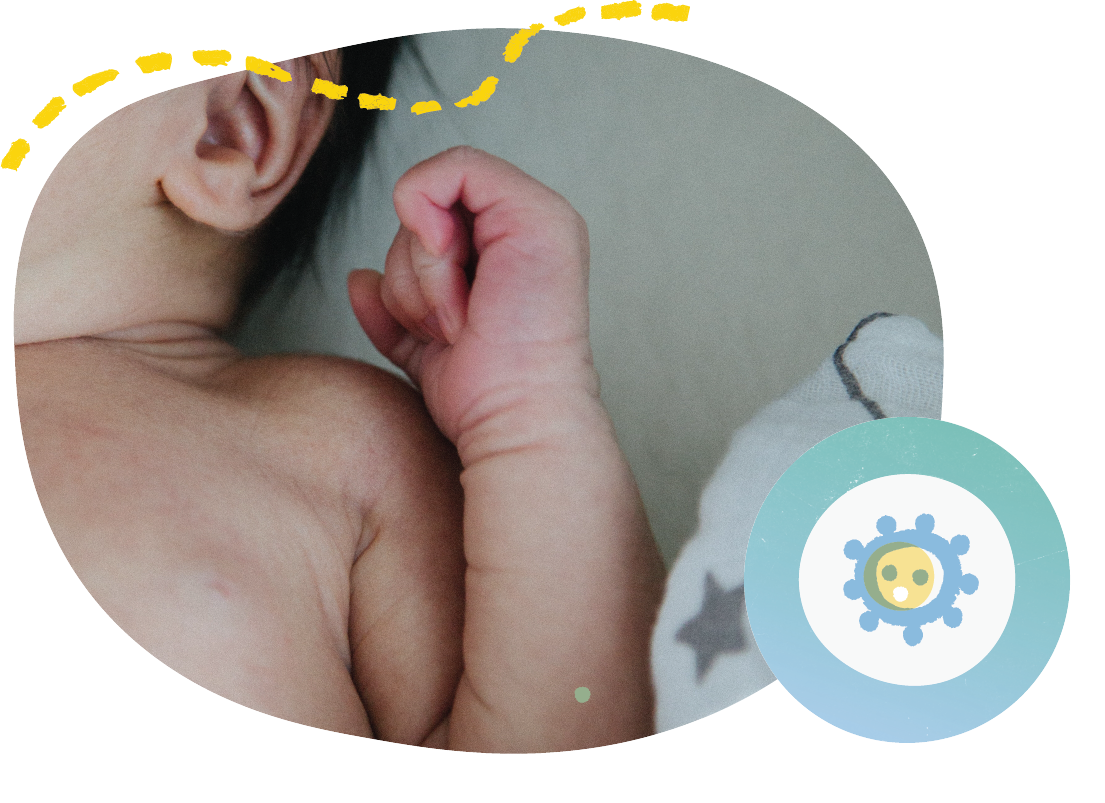

RSV is a common, respiratory virus that is more contagious than flu.1,2
In fact, around 2 out of 3 babies will get infected with RSV by the age of one.3
In most babies, an RSV infection usually causes mild symptoms like those
of a common cold, including a runny nose, sneezing, and congestion.4 It can
also be severe in some cases, and is an important cause of hospitalisation
in babies under 12 months.5–7

People of all ages can catch RSV, and 9 out of 10 babies have had RSV by the time they are 2 years old.8 However, certain groups of people including babies, the elderly, and some people with underlying health conditions, are more at risk of developing severe illness.9,10
While RSV often causes mild illness and cold-like symptoms, it can become more serious.4,9 Even if your child was born healthy and at full term, there is still a risk that they can become severely ill.5,11,12
RSV disease is unpredictable, so any baby is at risk of being hospitalised in their first year of life.5,13

Babies have small, fragile lungs, and their immune systems continue to mature and develop after birth. This may contribute to them being more vulnerable to developing serious illness due to RSV infection, compared to other age groups.14–17
Most babies only suffer with mild illness as a result of RSV infection, and recover at home without complications.4 But for some, RSV can cause more severe illnesses, such as bronchiolitis or pneumonia.4,18
For example, according to a study conducted in a major hospital in UAE, RSV was responsible for 51% of infants with bronchiolitis to be hospitalised.19
Unfortunately, there is no way to predict which babies will get seriously ill and require care in hospital when they are infected with RSV. 5,13




is a disease awareness initiative from EIDS to educate and inform parents, parents-to-be, and caregivers about illnesses in infants caused by RSV
Click to discover more about RSV and learn a few simple things that can help you protect your baby this RSV season.
GET THE FACTSDownload our RSV fact sheet and share what you have learned with someone you know. It just might make a world of difference.
DOWNLOAD (PDF)1. Liu L et al. Front Public Health 2021; 9: 587425.
2. Reis J and Shaman J. Infect Dis Model 2018; 3: 23–34.
3. Walsh E. Clin Chest Med 2017; 38(1): 29–36.
4. Piedimonte G and Perez M. Pediatr Rev 2014; 35(12): 519–530.
5. Demont C et al. BMC Infect Dis 2021; 21(1): 730.
6. Leader S and Kohlhase K. Pediatr Infect Dis J 2002; 21(7): 629–632.
7. Li Y et al. Lancet 2022; 399(10340): 2047–2064.
8. Simoes EAF. Lancet 1999; 354(9181): 847–852.
9. Coultas JA et al. Thorax 2019; 74(10): 986–993.
10. Centers for Disease Control and Prevention (CDC). RSV transmission. Available at: https://www.cdc.gov/rsv/about/transmission.html. Accessed: February 2023.
11. Arriola C et al. J Pediatric Infect Dis Soc 2020; 9(5): 587–595.
12. Hall CB et al. Pediatrics 2013; 132(2): e341–348.
13. Bianchini S et al. Microorganisms 2020; 8(12): 2048.
14. Di Cicco M et al. Pediatr Pulmonol 2021; 56(1): 240–251.
15. Esposito S et al. Hum Vaccin Immunother 2016; 12(7): 1700–1706.
16. Hussain M et al. Biochim Biophys Acta Mol Basis Dis 2017; 1863(12): 3226–3242.
17. Lambert L et al. Front Immunol 2014; 5: 466.
18. Meissner HC. N Engl J Med 2016; 374(1): 62–72.
19. Al Shibli, A. et al. (2021). Epidemiology of bronchiolitis in infants, Open Respir Med J, 15(1), 7–13. doi:10.2174/1874306402115010007.